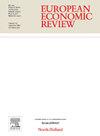A quantitative model of trust as a predictor of social group sizes and its implications for technology
IF 2.4
2区 经济学
Q1 ECONOMICS
引用次数: 0
Abstract
The human capacity for working together and with tools builds on cognitive abilities that, while not unique to humans, are most developed in humans both in scale and plasticity. Our capacity to engage with collaborators and with technology requires a continuous expenditure of attentive work that we show may be understood in terms of what is heuristically argued as ‘trust’ in socio-economic fields. By adopting a ‘social physics’ of information approach, we are able to bring dimensional analysis to bear on an anthropological-economic issue. The cognitive-economic trade-off between group size and rate of attention to detail is the connection between these. This allows humans to scale cooperative effort across groups, from teams to communities, with a trade-off between group size and attention. We show here that an accurate concept of trust follows a bipartite ‘economy of work’ model, and that this leads to correct predictions about the statistical distribution of group sizes in society. Trust is essentially a cognitive-economic issue that depends on the memory cost of past behaviour and on the frequency of attentive policing of intent. All this leads to the characteristic ‘fractal’ structure for human communities. The balance between attraction to some alpha attractor and dispersion due to conflict fully explains data from all relevant sources. The implications of our method suggest a broad applicability beyond purely social groupings to general resource constrained interactions, e.g. in work, technology, cybernetics, and generalized socio-economic systems of all kinds.
信任作为社会群体规模预测因子的定量模型及其对技术的影响
人类合作和使用工具的能力建立在认知能力的基础上,这种能力虽然不是人类独有的,但在规模和可塑性方面,人类都是最发达的。我们与合作者和技术合作的能力需要持续的专注工作,我们可以用启发式的方式来理解社会经济领域的“信任”。通过采用信息的“社会物理学”方法,我们能够将维度分析应用于人类学-经济学问题。群体规模和对细节的关注率之间的认知经济权衡是两者之间的联系。这使得人类能够在群体之间进行合作,从团队到社区,在群体规模和注意力之间进行权衡。我们在这里表明,一个准确的信任概念遵循一个两部分的“工作经济”模型,这导致了对社会群体规模统计分布的正确预测。信任本质上是一个认知经济问题,它依赖于过去行为的记忆成本和对意图的细心监督的频率。所有这些都导致了人类社会特征的“分形”结构。对某些α吸引子的吸引和由于冲突引起的色散之间的平衡完全解释了来自所有相关来源的数据。我们的方法暗示了一种广泛的适用性,超越了纯粹的社会群体,适用于一般的资源约束互动,例如在工作、技术、控制论和各种广义的社会经济系统中。
本文章由计算机程序翻译,如有差异,请以英文原文为准。
求助全文
约1分钟内获得全文
求助全文
来源期刊

European Economic Review
ECONOMICS-
CiteScore
4.70
自引率
3.60%
发文量
170
期刊介绍:
The European Economic Review (EER) started publishing in 1969 as the first research journal specifically aiming to contribute to the development and application of economics as a science in Europe. As a broad-based professional and international journal, the EER welcomes submissions of applied and theoretical research papers in all fields of economics. The aim of the EER is to contribute to the development of the science of economics and its applications, as well as to improve communication between academic researchers, teachers and policy makers across the European continent and beyond.
 求助内容:
求助内容: 应助结果提醒方式:
应助结果提醒方式:


